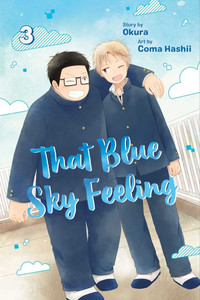Review
by Rebecca Silverman,That Blue Sky Feeling
GN 3
| Synopsis: |  |
||
Noshiro is really struggling to figure out who he is and just what his complicated feelings for Sanada are. It doesn't help that Sanada keeps insisting that Noshiro is straight, despite Noshiro not actually saying so. When a girl asks him out, things get even more confusing for the boys, as Sanada tries to suppress his own feelings, come out to Ayumi, and realize that maybe emotions aren't something you can just will away. |
|||
| Review: | |||
Despite years of thought to the contrary, there really aren't many, if any, binaries to human existence. Sexual and romantic preferences are definitely included in that, and the inability to look beyond the idea that you're either gay or you're straight has been one of the central issues of That Blue Sky Feeling, even if none of the characters have ever really voiced it. But Sanada's concerns about falling for Noshiro are very much caught up in the idea that he must be one or the other, ignoring the other possibilities that could make Noshiro's feelings for Sanada absolutely something he could act on, and that becomes a driving factor in this final volume of the series. While Sanada has been struggling with his feelings for his presumed straight friend, Noshiro, interestingly enough, hasn't ever come to the point where he's felt the need to classify himself. He definitely wants to understand what it means to be gay (if only in a strictly social sense, although this book sees him starting to think romantically), but he also wants to understand his own emotions. He's been drawn to Sanada from day one, but there's a definite sense that he wasn't sure if, or perhaps when, that became attraction as well. Previous to meeting Sanada, Noshiro didn't really have any strong romantic or sexual feelings for anyone, and he perhaps just assumed that he'd eventually fall for a girl when and if he met the right one. That he hasn't (and doesn't, despite opportunity in this volume) solidifies for him that his feelings for Sanada are more than just friendship, something outsider Makoto has been seeing from the beginning. Makoto is able to see more clearly than the boys in question themselves because he's on the outside of their relationship. Although Noshiro (and a much more reluctant Sanada) do accept Makoto into their friend group, Makoto is very clear that he has a crush on Noshiro, and in fact initially assumed that Noshiro was gay, the exact opposite assumption from Sanada's. Because of this and the close attention he pays to his crush, Makoto is in a better position to see through the misdirection the other two are, at least to a degree, allowing themselves to enact and believe in. The same goes for Hide, Sanada's ex-boyfriend, who has been an advocate of both openly telling Noshiro whatever he wants to know and of the two getting together. In fact, the sleepover at his apartment is when we really begin to see that the veneer Noshiro and Sanada have put on is cracking. Both boys begin to exhibit signs of jealousy and discomfort. Sanada doesn't want Hide to tell Noshiro about their relationship or Makoto to hit on him, while Noshiro, somewhat to his surprise, finds that he's really uncomfortable with the idea that Sanada had a physical relationship with Hide. It's not because he's not a fan of the idea of two men having such a relationship, but rather that he doesn't like the fact that Sanada had one with someone else – and though he can't say it, he certainly seems to be at least a little jealous of it. This, along with a girl friend of Makoto's asking Noshiro out, form the major groundwork that brings the ending to fruition. Coming on the heels of Makoto asking Noshiro out and being gently rejected, Noshiro seems to feel like he needs to accept the girl, but even if he's not actually aware of it, it is clear to readers that he's hoping to provoke a reaction in Sanada at least a little bit. When he fails to do so, Noshiro becomes much more introspective about the difference between being “friends” and “liking” someone, inadvertently helped by the girl. When she wants a slightly more physical relationship, Noshiro begins talking about Sanada, she worries that he's got a crush on someone else. Those words are ultimately what pushes Noshiro into truly thinking about his feelings, while at the same time Ayumi is forcing Sanada to do the same. For Sanada, it becomes a question of “natural” versus “unnatural,” revealing that at least to a degree he feels that being gay is somehow the latter. That, perhaps, more than anything he's said before, is what's been holding him back from admitting that he likes Noshiro, becoming the author of his own unhappiness. At the end of the day, it's feelings, not labels, that triumph. Noshiro thinks that he still doesn't know “what” he is – straight or gay – but that it ultimately doesn't matter. More knowledgeable readers might say that he's bi-or-pansexual, or asexual homoromantic, but again, none of that really is important in the context of the story. That Blue Sky Feeling ends with the idea that it doesn't matter who you love; what matters is that you love them. That makes it a story that feels more inclusive than if it was a strictly gay or lesbian story; it's for anyone who just likes who they like. It's a message that often gets lost among the labels, and it's perhaps more meaningful for it. |
| Grade: | |||
|
Overall : A-
Story : A-
Art : B
+ Warm, meaningful ending that leaves the characters room to grow. Nice use of series themes. |
|||
| Production Info: | ||
|
Full encyclopedia details about |
||